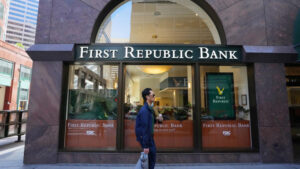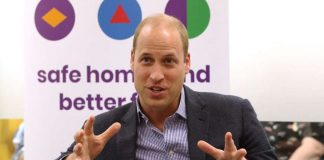MAY 1, 2023

First Republic, whose assets were battered by the rise in interest rates, struggled to avoid a government takeover. – Jim Wilson/NY Times
Regulators seized control of First Republic Bank and sold it to JPMorgan Chase on Monday, a dramatic move aimed at curbing a two-month banking crisis that has rattled the financial system.
First Republic, whose assets were battered by the rise in interest rates, had struggled to stay alive after two other lenders collapsed last month, spooking depositors and investors.
First Republic was taken over by the Federal Deposit Insurance Corporation and immediately sold to JPMorgan. The deal was announced hours before U.S. markets are set to open, and after a scramble by officials over the weekend.
Later on Monday, 84 First Republic branches in eight states will reopen as JPMorgan branches.
JPMorgan will “assume all of the deposits and substantially all of the assets of First Republic Bank,” the F.D.I.C. said in a statement. The regulator estimated that its insurance fund would have to pay out about $13 billion to cover First Republic’s losses. JPMorgan also said that the F.D.I.C. would provide it with $50 billion in financing.
“Our government invited us and others to step up, and we did,” said Jamie Dimon, JPMorgan’s chief executive. He said the transaction was intended “to minimize costs to the Deposit Insurance Fund.”
The acquisition makes JPMorgan, already the nation’s largest bank, even bigger and could draw political scrutiny from progressive Democrats in Washington.
First Republic failed despite having received a $30 billion lifeline from 11 of the country’s largest banks in March. JPMorgan said the $30 billion would be repaid after the deal closes. Overall, First Republic will go down in history as the second largest U.S. bank by assets to collapse after Washington Mutual, which failed during the financial crisis of 2008.
The government’s takeover and sale of First Republic comes seven weeks after the government took control of Silicon Valley Bank and Signature Bank, whose failures sent a shock wave through the industry and raised fears that other regional banks were at risk of similar runs on deposits.
Many banking experts said First Republic’s travails were a delayed reaction to the turmoil in March rather than the opening of a new phase in the crisis. Investors and industry executives are optimistic that no other midsize or large lenders are at risk of imminent failure. As First Republic’s stock plunged anew last week, other bank stocks barely budged.
Even so, the U.S. financial system has plenty of problems. The recent bank failures and rising interest rates have forced banks to rein in lending, making it harder for businesses to expand and individuals to buy homes and cars. That is one of the reasons that the economy has been slowing in recent months.
JPMorgan shares rose about 3 percent in premarket trading, while the S&P 500 was poised for a flat open.
“First Republic was known to be the main item of remaining unfinished business from the bank stress in March,” said Krishna Guha, head of the global policy and the central bank strategy team at Evercore ISI. He said that his expectation, given that the seizure was widely expected, was that “this will not result in large spillovers in financial markets.”
The $30 billion cash infusion helped calm broader fears about the banking system but did not put to rest concerns about the viability of First Republic. The lender, founded in 1985, was the 14th-largest bank in the United States at the start of this year. Its shares lost nearly all of their value after a relentless series of steep declines that began as Silicon Valley Bank was teetering.
The end of First Republic came after weeks in which the bank and its advisers sought either to save the bank or find a buyer outside of a government takeover. But the efforts fell flat: Other banks were reluctant to buy it or pieces of the bank without assurances that they wouldn’t be left with billions of dollars in losses. By last week, after an alarming earnings report in which the bank disclosed that customers had withdrawn more than half of its deposits, it became clear that there was no option outside a government takeover.
Late last week, the F.D.I.C. reached out to other financial institutions, including JPMorgan Chase, PNC Financial Services and Bank of America, seeking bids for First Republic. Bidders had until noon Sunday to submit their offers. As part of the bidding process, banks were also asked what parts of the bank they wouldn’t accept.
Like the other two failed banks — Silicon Valley Bank and Signature — First Republic collapsed under the weight of loans and investments that lost billions of dollars in value as the Federal Reserve rapidly raised interest rates to fight inflation. When it started becoming apparent that those assets were now worth much less, First Republic’s affluent customers, most of whom live on the coasts, began pulling their money out as quickly as they could and investors dumped its shares.
Last Monday, First Republic revealed that clients had pulled $102 billion in deposits in the first three months of the year — well over half the $176 billion it held at the end of 2022. It also said it had borrowed $92 billion, mostly from the Fed and government-backed lending groups, effectively acknowledging that it had to turn to the financial industry’s lenders of last resort to keep the doors open.
The bank’s grim financial statement only fanned the worst fears of investors — that the F.D.I.C. would have to take over the bank.
By Thursday night, First Republic and its advisers were aware that it was out of options aside from a government takeover. The F.D.I.C. worked with the financial advisory firm Guggenheim Partners on the process, according to three people with knowledge of the situation.
Federal regulators are in defense mode. Last week the Fed and the F.D.I.C. published reports criticizing themselves for failing to adequately regulate Silicon Valley Bank and Signature. The reports also blamed the banks for poor management and excessive risk-taking.
First Republic had many clients in the start-up industry — similar to Silicon Valley Bank — and in the financial industry, including senior bankers and hedge fund managers. Many of its accounts held more than $250,000, the limit for federal deposit insurance.
First Republic’s collapse could add to concerns about an economic slowdown. The upheaval that began with the failure of Silicon Valley Bank has made banks and investors more cautious, industry experts and economists say. And that caution could make lending more difficult and costly, impeding business expansion and hiring.
First Republic’s closure probably keeps the Fed on track to raise interest rates a quarter point at its meeting on Wednesday, Mr. Guha said, as has been widely expected. In fact, he said, it may “clear the decks” for such a move by taking away a lingering source of risk and uncertainty.
But Mr. Guha said that the banking issues were moving from an “acute” to a “chronic” phase: Other lenders may look at First Republic and the other recent bank failures and try to shore up their own positions by becoming more cautious about lending.
“The macroeconomic effects of bank stress may only be in the early stage of unfolding,” Mr. Guha said.
Because of the types of clients it served — a large portion of them multimillionaires — the bank’s executives often spoke about the safety of its business model and its growth. Its customer base had little history of defaults, but the bank underwrote mortgages when interest rates were very low and kept them on its books rather than selling them to investors. First Republic’s large hoard of home loans lost value every time mortgage rates on new loans climbed over the last year.
Other regional lenders, like Utah’s Zions Bank and PacWest of Los Angeles, have firmed their footing faster than First Republic, and bank analysts do not see another collapse as imminent. The stocks of every other bank in the S&P 500 stock index rose on Friday even as First Republic’s shares ended the day down more than 40 percent in anticipation of the government takeover.
Courtesy/Source: NY Times










































































































